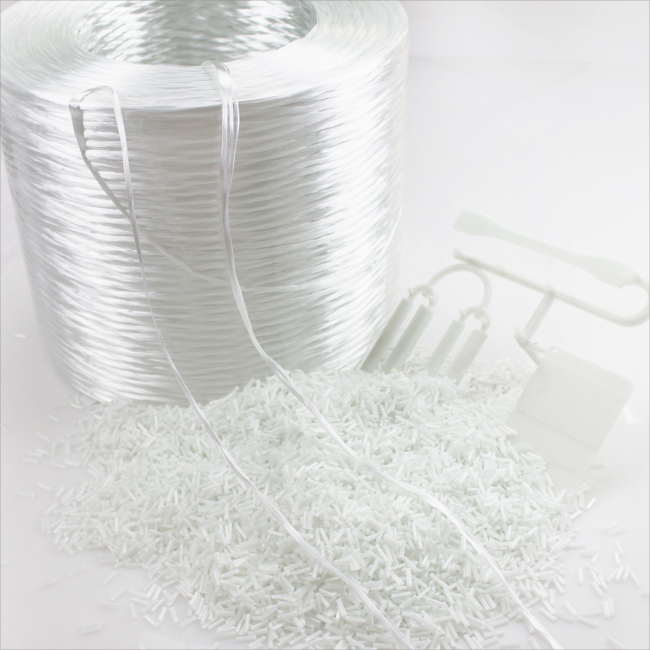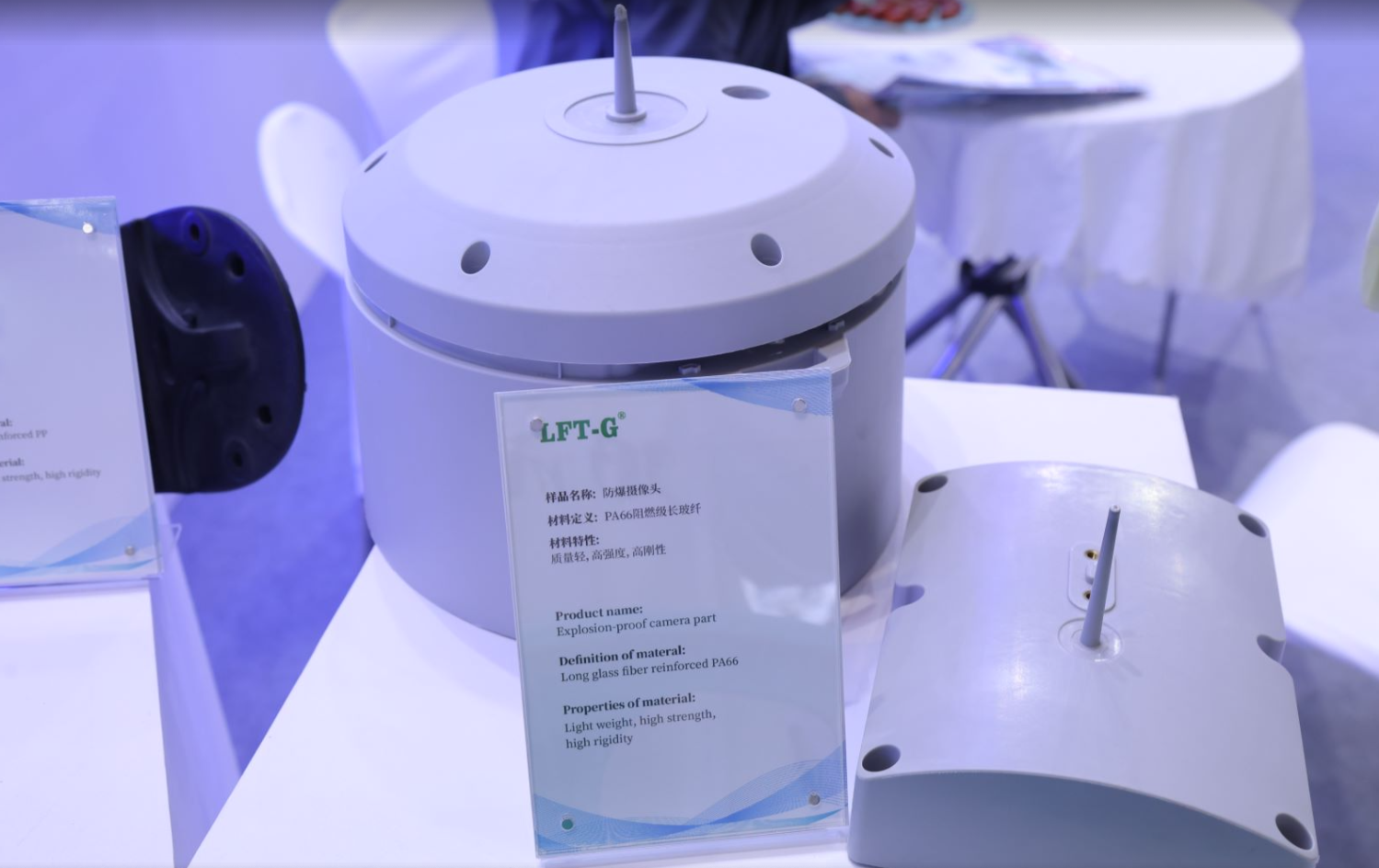
〈7〉ポリアミド〈8〉は一般にナイロン(PA)として知られており、ポリマー主鎖に多数のアミド基が含まれており、これらのアミド基同士が水素結合を形成しやすく、アミド基間の力が弱いことが大きな特徴です。 PAの分子鎖は強力です。したがって、PAは高い結晶性、高い表面硬度、優れた化学的安定性、高い引張強度と曲げ強度、耐摩耗性、耐熱性などの特性を備えています。
しかし、PAには多くの欠陥があり、その主な欠陥は、外部環境の温度と湿度がPAの衝撃強度、寸法安定性、吸水性に大きな影響を与えることです。
純粋な PA 材料は多くの場合、実際の使用ニーズを満たすことができません。したがって、通常は変更を検討する必要があります。
無機改質剤の添加または他のポリマーとのブレンドによる PA 材料の改質により、高強度、耐摩耗性、耐低温性などの高性能要件を満たす合金を調製します。
無機改質剤は有機改質剤と比較して強度と熱安定性が高く、PA の主な改質剤となっています。 PA改質用の無機改質剤としては、主に炭酸カルシウムなどの無機粒子やガラス繊維(GF)などの繊維材料が挙げられる21)。

GF は低コストであるだけでなく、高い引張強さ、低い破断伸び、高い弾性率、良好な機械的特性、耐熱性および寸法安定性などの特性を備えています。 Gf は、優れた特性を備えた一般的に使用されるポリマー改質材料です [37]。
GFによるPAの修飾については多くの研究が行われている。しかし、報告されているさまざまな PA/GF 複合材料の機械的特性と熱的特性には依然として大きな違いがあります。これは、PA/GF 複合材料の特性が PA と GF の含有量以外の多くの要因の影響を受けるためです [40]。
例えば、GFとPAの界面力(GFの表面処理、PAのマトリックス改質)、GFの直径、押出機のスクリューの組み合わせ、GFと他の無機フィラーの相乗効果などである。

カメラ部 LFT-G製®¸PA66+GF40
上記の要因に基づいて、この論文では PA/GF 複合材料の影響を検討します。
1. PA/GF 複合材料の特性に対する PA マトリックスと GF の間の界面力の影響
1) PA/GF 複合材料の特性に対するガラス繊維表面改質の影響
GFとPA樹脂の極性差が大きいため、両者の相溶性は悪く、両者の界面力は弱い。外力を受けると、GF と PA の間の界面剥離が起こりやすく、これは GF の PA に対する増強効果に重大な影響を与えます。
したがって、GFの表面有機修飾は通常、GFとPAの間の相溶性、GFとPAの間の界面力、およびPAマトリックス中のGFの分散を改善するために行われる[75]。
カップリング剤は、ガラス、セメント、金属などの無機材料や合成樹脂などの有機材料と相互作用できる基を有する特殊な構造を有する化合物の一種です。 2 つ以上の物質間の適合性を向上させるために使用でき、幅広い用途があります。[79]
GF の表面修飾に一般的に使用されるカップリング剤は主にシランカップリング剤ですが、その他にチタネートカップリング剤も GF の表面修飾に使用されます。
チタネートカップリング剤は水中で加水分解しやすいため、多数の気泡が発生し、PA材料は水を吸収しやすいため、PAマトリックス中のGFを修飾するためのチタネートカップリング剤の適用は制限されます。
*孫鵬ら。 PA6/の特性に及ぼす水溶液中のシラン カップリング剤アミノプロピル トリエトキシシラン (KH550) の濃度の影響と、さまざまなシラン カップリング剤 (シアノエチル トリエトキシシラン、KH550 および γ-グリシジル エーテル オキシプロピル トリメトキシシラン (KH560)) による GF の修飾の影響を研究しました。 GF 複合材料。
* 結果は、1.5% KH550 水溶液によって改質された PA6/GF 複合材料の特性が最高であることを示しています。 KH550 および KH560 と比較して、シアノエチルトリエトキシシランによって修飾された PA6/GF 複合材料の特性は優れています。
*ただし、3 種類のシランカップリング剤で修飾された PA6/GF 複合材料の引張特性、曲げ特性、衝撃特性は改善されました。これは、未処理の GF の表面が滑らかで、PA6 マトリックスからの引き抜きが容易であるためです。改質 GF と PA6 マトリックス間の界面力は大きく、引張断面は交互に配置されています。
さらに、産業界で一般的に使用される GF 表面改質剤は、浸透剤と呼ばれるさまざまな物質の混合物であることがよくあります。現在、一般的なGF浸透剤には、主に皮膜形成剤、カップリング剤、潤滑剤、帯電防止剤などを含む多くの成分が含まれている。その中でも、皮膜形成剤は浸透剤の品質を決定する非常に重要である
。
*Li Cuihong 他。 GFを改質するためのエポキシ樹脂改質ポリウレタン膜形成剤を合成し、PA66/GF複合材料を調製した。結果は、エポキシ基の存在により、修飾されたGFがPA66樹脂のアミド基と化学反応することができ、GFとPA樹脂の間の界面力が大幅に増加し、PA66/の機械的特性と耐加水分解性が向上することを示しています。 GFコンポジット
※GFをシランカップリング剤で変性し、PA複合材料に適用しましたが、変性効果は乏しかったです。したがって、近年、研究者らは、新しいシランカップリング剤を合成するか、他の表面改質剤を使用することによってGFを改質し、それらをPAマトリックスに適用して、GFとPAの間の界面力をさらに改善している
。
*Liu Yuku 他。シアノエチルトリクロロシランと無水酢酸を用いて新規シランカップリング剤(N1-A)を合成し、GFの表面修飾に使用した
。
*Sun Peng らの研究とは異なり、KH550 改質 PA 複合材料と比較して、新しいカップリング剤 N1-A が表面改質剤処理溶液のわずか 0.5% である場合、引張強度、曲げ強度、曲げ強度は修飾された PA6/GF 複合材料の弾性率は大幅に高くなっています。
※これは、N1-Aが酢酸に加水分解され、酸触媒の作用によりアミド基とカルボン酸基がさらに生成され、生成したアミド基がPA6マトリックスと水素結合を形成し、カルボン酸基が化学反応するためです。 PA6 マトリックスにアミド結合があり、PA マトリックスと GF の間の界面力が向上します。
実際、シランカップリング剤を使用する過程で、メタノールやエタノールなどの揮発性小分子化合物が生成され、特定の環境危険をもたらします。
*イガイ接着の生物学的原理に基づいて、Luo Kaiqiang et al.酸化・自己重合法によりGF表面にドーパミンをコーティングすることに成功しました。ドーパミンの表面に多くの極性基が存在するため、GFとPAマトリックスの間に強い水素結合相互作用が形成され、GFとPAの間に強い界面力が形成されました
。
*実験結果は、PA6に対するGFの増強効果がKH550で修飾されたGFよりも優れており、この方法が環境に優しく経済的であり、調製プロセスが簡単であることを示しています
。
要約すると、カップリング剤または他の表面改質剤の主な目的は、GF と PA マトリックス間の界面力を改善することです。 PA/GF 複合材料の機械的特性と耐加水分解性は、GF と PA マトリックスの間の界面力を増加させることによって大幅に改善されます。

LFT製自動車部品®ã PA66+GF
2) PA/GF 複合材料の特性に対するナイロンマトリックスの改質の影響
GFの表面修飾に加えて、PAマトリックスは、PA/GF界面力を増大させることによってさらに修飾することができる。 PAマトリックスの改変には、主に、PAマトリックスに相溶化剤または他の改質剤を追加することが含まれる。これらの改質剤は、PA マトリックスと GF の間の相互作用力を強化し、PA/GF 複合材料の機械的特性を向上させることができます。
*周麗華ほか。無水マレイン酸グラフトエチレン-オクテン共重合体 (POE-g-MAH) を、容量付与強化剤として PA6T/GF 複合材料に添加しました。結果は、POE-g-MAHの含有量が5%の場合、PA6T/GF複合材料の引張強度が約20%増加し、曲げ強度が10%増加することを示している。
これは、POE-g-MAH 鎖上の酸無水物が PA66 分子鎖上のアミド基と化学反応し、GF 表面の水酸基とも反応して、GF 間の界面力を増加させるためです。およびPA66。
強い界面力を持つ PA6T/GF/POE-g-MAH 複合材料の GF の表面は粗く、GF と PA 樹脂間の結合が良好であることを示しています。 GF の表面は滑らかで、界面力の弱い複合部分でも引き抜きやすくなっています。
要約すると、相溶化剤は、GFとPAの間の相互作用力を増大させることによって複合材料の機械的特性を改善します。
相溶化剤に加えて、一部の流動調整剤も PA マトリックスと GF の間の界面力を改善することができます。
*ドヒョンほか。 PA66/GF複合材料を改質するために、それぞれヘキサンジアミン、ドデカメチレンジアミン、4,4'-メチレンビス(シクロヘキサンアミド)および脂肪酸を使用して、3つの流動改質剤HMDA、DMDAおよびMCHAを調製した。
*流動調整剤の添加により、PA66/GF 複合材料の流動性が向上するだけでなく、流動調整剤の主鎖にアミド結合が存在するため、PA66 と GF の両方との水素結合が生成され、界面界面の反応速度が増加します。 GFとPA66マトリックス間の力を強化し、PA66マトリックス中のGFの分散を改善します。 PA66/GF 複合材料の引張強度と曲げ弾性率が向上します。
[171]要約すると、GFとPAマトリックスの間の相互作用力は、GF表面とPAマトリックスの両方を修飾することによって改善でき、それによってPAマトリックス中のGFの分散が改善され、PA/GF複合材料の機械的特性が改善される。
2. PA/GF 複合材料の特性に対する GF 直径の影響
PAマトリックスとGFの間の界面力に加えて、GFの特性もPA/GF複合材料の特性を決定する重要な要素である。たとえば、GF の直径、サイズ、強度、弾性率、その他の機械的特性などです。現在、市場での GF の強度と弾性率の差は小さく、GF の直径は大きくなります。 GF の直径が PA/GF 複合材料の特性に大きな影響を与えることが示されています
。
* GF と異なる直径 (15、13、11、10μm) の PA66 樹脂間の接触面積は、Zhijian Zhang らによって理論的に計算されました。結果は、GF と PA66 マトリックス樹脂間の接触面積の比が 1:1.1 ~ 1.3 ~ 1.5 であることを示しています。
*実験結果は、PA66/GF複合材料の引張強さと衝撃強さは、GFとマトリックスの接触面積の増加に伴って増加することを示しています。これは、GFとPA樹脂の接触面積が大きいほど、両者の間の界面力が大きくなるためです。さらに、GF の直径が大きくなるにつれて、GF の表面はより滑らかになり、樹脂との「ヒンジ度」は減少します。
*Tang Youqian 他。は、GF の直径が異なる PA6/30%GF 複合材の性能の違いを研究しました。その結果を表 1 に示します。表 1 からわかるように、GF の直径が小さいほど、引張強度、曲げ強度、曲げ強度が高くなります。材料の弾性率と衝撃強さが向上し、メルトフローレートが高くなります。しかし、GFの直径が10μm未満になると、価格が大幅に高くなり、コストパフォーマンスが低くなり、実際の使用価値が低くなる。
3. PA/GF 複合材料の性能に対するネジの組み合わせの影響
上記の PA/GF 複合材料に加えて、加工技術も PA/GF 複合材料の性能を決定する要素の 1 つです。その中で、PA/GF複合押出機を製造するためのスクリューの組み合わせが最も影響力がある
。
これは、ねじの組み合わせが PA マトリックス中の GF の長さと分散を大きく決定するためです。結果は、PA マトリックス中の GF の長さが 300 から 400 μm の範囲であるとき、PA マトリックス上の GF の強化および強化効果が優れており、PA マトリックス上の長すぎるまたは短すぎる GF の強化および強化効果が劣ることを示しています。
これは、GFが短すぎるとマトリックスに浸透することが難しく、GFが長すぎるとPAマトリックス中に均一に分散することが困難になるためである。スクリューの作用により、スクリューのせん断力がGFの長さに大きく影響します。 GF 強化ポリマーのスクリュー結合は、供給セクション、溶融セクション、第 2 供給セクション、混合セクションおよび排出セクションから構成され、GF の長さは主に混合セクションによって影響されます。
適切な長さの GF と PA マトリックス中での良好な分散を得るために、メッシュ ブロックの数を増減したり、スクリュー内のメッシュ ブロックの位置を調整したりすることで、スクリューのせん断能力を調整できます。具体的なスクリューの組み合わせ方法は、押出機の型番、スクリューの長さと直径の比などの要因に応じて決定する必要があります。
噛み合うブロックに加えて、歯板や逆歯板などの特殊な形状のねじ要素も PA/GF 複合材料の調製に効果的です。ギアディスク要素は GF の分散を改善し、GF の摩耗を軽減します。
その中で、SME歯ディスク要素のスパイラルエッジの開口により、その搬送能力と減圧能力が低下し、スパイラル溝内の材料の充填度が増加し、その滞留時間が延長されます。素材。したがって、歯板要素はねじの組み合わせに使用され、PA66/GF 複合材料の引張強度、曲げ強度、衝撃強度が大幅に向上します。
*陳百泉ら。は、高 GF 充填率の PA6 複合材料を調製するために、押出機の混合セクション用に 3 つのスクリューの組み合わせを設計しました。
結果は、1 セットの厚いメッシュブロックと 1 セットの SME 歯混合要素を使用し、2 セットの薄いメッシュブロックねじの組み合わせを追加し、第 2 のサイドフィード添加 GF と組み合わせることで、GF の分散均一性が向上することを示しています。準備された PA6/GF 複合材料の方が優れており、長さは 300 ~ 500μm です。 PA6/GF 複合材料の機械的特性は大幅に改善されています。
*Jiang Zhaoyin 他。は、逆歯板を PA66/GF 複合ネジの製造に適用し、さまざまなネジの組み合わせを設計しました。
研究によると、噛合ブロックと比較して、逆歯プレートは PA66 と GF を均一に混合し、搬送効率を向上させるだけでなく、スクリューのせん断強度を適切に低下させ、溶融状態での GF の摩耗度を軽減することができます。せん断力を高め、GF の長さと完全性を確保し、PA66/GF 複合材料の欠陥を減らし、複合材料の機械的特性を改善します。
上記の研究状況は、噛み合うブロック、歯板、および逆歯板要素のねじの組み合わせを使用することにより、より優れた性能を有するPA/GF複合材料が得られることを示している。同時に、ネジの組み合わせは GF の送り位置と密接に関係しており、最適なネジを実現するには、GF の送りモードに応じて噛合ブロック、歯板、逆歯板要素の相対位置を調整する必要があります。せん断
4. PA 複合材料の特性に対する GF と他の無機フィラーの相乗効果の影響
GF は PA の機械的特性を高める上で明らかな役割を果たしますが、PA マトリックスを脆くし、サンプルの外観を悪くすることもあります。
無機ナノ粒子は比表面積が大きく、表面に多くの活性点を持ち、さまざまな種類の界面活性剤で修飾して PA 材料との適合性を向上させることができます。例えば、修飾された無機ナノ粒子は、PA材料のアミド基と化学反応して、ファンデルワールス力よりもはるかに大きい良好な界面力を生成することができる
。
同時に、無機フィラーには粒状、フレーク状、繊維状などの様々な形状があり、無機フィラーの異なる形状は異なる改質効果を有する。したがって、無機充填剤はPA/GF複合材料の性能欠陥を改善することができ、無機充填剤とGFによるPAの相乗的改質によりPA/GF複合材料の性能をさらに向上させることができる
。
PA/GF 複合材料では、タルク粉末やモンモリロナイトなどのフレーク状無機充填剤が広く使用されています。
*Yang Zhen 他。は、PA66 複合材料の機械的特性に対するタルクと GF の比率の影響を研究しました。
*結果は、純粋な PA66、PA66/30% タルク粉末、PA66/30%GF と比較して、PA66/タルク/GF の質量比が 70/5 の場合、複合材料の引張強度、曲げ強度、衝撃強度が大幅に向上することを示しています。 /25.
これは、タルクとGFがPA66マトリックス中に均一に分散しているという事実によるものである。材料が応力を受けると、タルク粒子の応力集中により PA マトリックスが変形し、銀線が形成され、大量の変形仕事を吸収します。
さらに、層状タルクに沿った GF の多軸配向により、GF の「骨格」はより大きな応力に耐えることができます。 GFとタルクはそれぞれの利点を最大限に発揮します。したがって、GFと無機フィラーを適切に添加することにより、PAマトリックスに対する相乗的な強化効果を実現することができます。この現象は、Shen ChaoらによるPA6/GF/タルク発泡複合材料の調製の研究でも検証されている[269]。
同時に、タルクは潤滑効果があり、複合材料の浮き繊維現象を軽減し、射出サンプルの反り変形を抑制できます。 PA66/GF/タルクの質量比が70/10/20の場合、複合材料の見かけの特性は大幅に改善されます。
*さらに、Hu Jin et al.有機モンモリロナイト (OMMT) を使用して PA66 を GF で共修飾しました。結果は、PA66/GF/MMTの質量比が100/25/7の場合、PA66/GF/OMMT複合材料の引張強さ、曲げ強さ、衝撃強さが最大値に達し、PA66複合材料よりも優れていることを示しています。 GFまたはOMMTを単独で添加。
*これは、OMMT 層が剥離されて PA66 マトリックス内に均一に分散され、OMMT が PA66 マトリックス内で核剤として作用し、PA66 の結晶性が向上し、複合材料の強度が向上するという事実によるものです。 .
薄片状無機充填剤に加えて、いくつかの研究では針状無機充填剤とGFを使用してPAを共修飾しています。
*Ma らは、溶融混合によって PA6/GF/珪灰石複合材料を調製しました。これにより、複合材料の引張強度と曲げ強度が向上し、GF で強化された PA6 の表面特性も向上しました。
*GF は PA6 を大幅に強化し、珪灰石は複合材料の収縮を低減します。ワラストナイトと GF の合計量が 30% (ワラストナイトと GF の質量比が 1:2) の場合、材料の機械的特性と表面特性はより優れています。
上記の研究はすべて、PA/GF複合材料をフレークまたは針状の無機充填剤およびGFで改質することができ、これによりPA/GF複合材料の機械的特性および見かけの特性を向上させることができることを示している。したがって、無機充填剤とGFによるPAの相乗的改質は、PA/GF複合材料の重要な研究方向となっている。
5.結論
要約すると、既存の文献は、GF と PA の間の界面力が GF 表面改質と PA マトリックス改質によって改善され、PA マトリックス中の GF の分散が改善され、PA/GF 複合材料の機械的特性と耐加水分解性が向上できることを示しています。改善することができます。 GF の直径が小さいほど PA/GF 複合材料の機械的特性は向上しますが、GF の直径が小さいほど高品質になります。
PA/GF 複合材料の機械的特性は、歯形ディスクまたは逆歯形ディスクと噛み合いブロックを合理的に使用することによって大幅に改善できます。他の無機フィラーと GF で改質された PA 複合材料の機械的特性は、GF のみで改質されたものよりも優れています。さらに、他の無機フィラーは、PAマトリックス中のGFの浮遊繊維現象を改善し、より優れた見かけの特性を得ることができます
。
現在、GF 改質 PA 複合材料の主な研究方向は、強化、靱性、耐熱性、寸法安定性などです。将来の GF 改質ナイロン複合材料の研究方向は次のとおりです。
(1) GF 表面改質剤を最適化し、新しく効率的な表面改質剤の開発に焦点を当て、マトリックスと GF の間の界面力をさらに改善し、PA マトリックス中の GF の分散を改善し、より高い機械的および熱的特性を備えた PA/GF 複合材料を得るプロパティ。
(2) PA/GF 複合材料の加工流動性を改善し、加工中の PA マトリックスの劣化を軽減するために、より優れた流動 AIDS を追求します。
(3) 他の無機フィラーとGFによるPAの相乗的修飾を最適化し、GFと無機フィラーの相乗メカニズムを解明し、PA/GF複合材料の性能を向上させ、PA/GF複合材料の適用範囲を拡大する。 318
タグ :